En Zhu
Generalized Deep Multi-view Clustering via Causal Learning with Partially Aligned Cross-view Correspondence
Sep 19, 2025Abstract:Multi-view clustering (MVC) aims to explore the common clustering structure across multiple views. Many existing MVC methods heavily rely on the assumption of view consistency, where alignments for corresponding samples across different views are ordered in advance. However, real-world scenarios often present a challenge as only partial data is consistently aligned across different views, restricting the overall clustering performance. In this work, we consider the model performance decreasing phenomenon caused by data order shift (i.e., from fully to partially aligned) as a generalized multi-view clustering problem. To tackle this problem, we design a causal multi-view clustering network, termed CauMVC. We adopt a causal modeling approach to understand multi-view clustering procedure. To be specific, we formulate the partially aligned data as an intervention and multi-view clustering with partially aligned data as an post-intervention inference. However, obtaining invariant features directly can be challenging. Thus, we design a Variational Auto-Encoder for causal learning by incorporating an encoder from existing information to estimate the invariant features. Moreover, a decoder is designed to perform the post-intervention inference. Lastly, we design a contrastive regularizer to capture sample correlations. To the best of our knowledge, this paper is the first work to deal generalized multi-view clustering via causal learning. Empirical experiments on both fully and partially aligned data illustrate the strong generalization and effectiveness of CauMVC.
Intra-view and Inter-view Correlation Guided Multi-view Novel Class Discovery
Jul 16, 2025Abstract:In this paper, we address the problem of novel class discovery (NCD), which aims to cluster novel classes by leveraging knowledge from disjoint known classes. While recent advances have made significant progress in this area, existing NCD methods face two major limitations. First, they primarily focus on single-view data (e.g., images), overlooking the increasingly common multi-view data, such as multi-omics datasets used in disease diagnosis. Second, their reliance on pseudo-labels to supervise novel class clustering often results in unstable performance, as pseudo-label quality is highly sensitive to factors such as data noise and feature dimensionality. To address these challenges, we propose a novel framework named Intra-view and Inter-view Correlation Guided Multi-view Novel Class Discovery (IICMVNCD), which is the first attempt to explore NCD in multi-view setting so far. Specifically, at the intra-view level, leveraging the distributional similarity between known and novel classes, we employ matrix factorization to decompose features into view-specific shared base matrices and factor matrices. The base matrices capture distributional consistency among the two datasets, while the factor matrices model pairwise relationships between samples. At the inter-view level, we utilize view relationships among known classes to guide the clustering of novel classes. This includes generating predicted labels through the weighted fusion of factor matrices and dynamically adjusting view weights of known classes based on the supervision loss, which are then transferred to novel class learning. Experimental results validate the effectiveness of our proposed approach.
Automatically Identify and Rectify: Robust Deep Contrastive Multi-view Clustering in Noisy Scenarios
May 27, 2025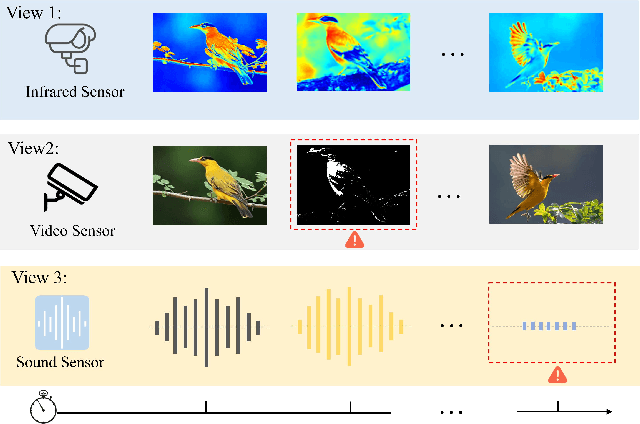
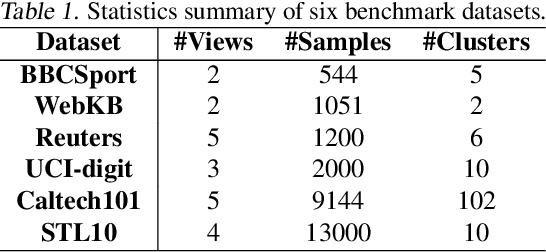
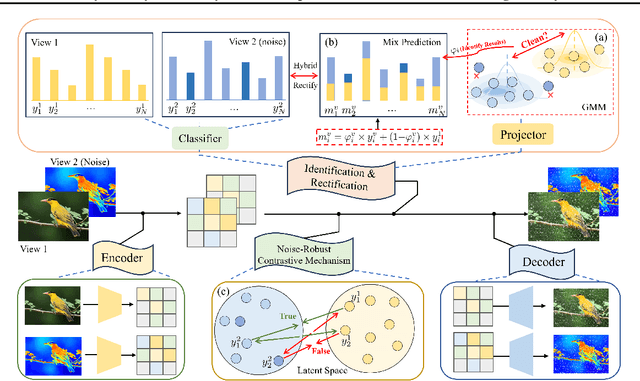

Abstract:Leveraging the powerful representation learning capabilities, deep multi-view clustering methods have demonstrated reliable performance by effectively integrating multi-source information from diverse views in recent years. Most existing methods rely on the assumption of clean views. However, noise is pervasive in real-world scenarios, leading to a significant degradation in performance. To tackle this problem, we propose a novel multi-view clustering framework for the automatic identification and rectification of noisy data, termed AIRMVC. Specifically, we reformulate noisy identification as an anomaly identification problem using GMM. We then design a hybrid rectification strategy to mitigate the adverse effects of noisy data based on the identification results. Furthermore, we introduce a noise-robust contrastive mechanism to generate reliable representations. Additionally, we provide a theoretical proof demonstrating that these representations can discard noisy information, thereby improving the performance of downstream tasks. Extensive experiments on six benchmark datasets demonstrate that AIRMVC outperforms state-of-the-art algorithms in terms of robustness in noisy scenarios. The code of AIRMVC are available at https://github.com/xihongyang1999/AIRMVC on Github.
Imputation-free and Alignment-free: Incomplete Multi-view Clustering Driven by Consensus Semantic Learning
May 16, 2025Abstract:In incomplete multi-view clustering (IMVC), missing data induce prototype shifts within views and semantic inconsistencies across views. A feasible solution is to explore cross-view consistency in paired complete observations, further imputing and aligning the similarity relationships inherently shared across views. Nevertheless, existing methods are constrained by two-tiered limitations: (1) Neither instance- nor cluster-level consistency learning construct a semantic space shared across views to learn consensus semantics. The former enforces cross-view instances alignment, and wrongly regards unpaired observations with semantic consistency as negative pairs; the latter focuses on cross-view cluster counterparts while coarsely handling fine-grained intra-cluster relationships within views. (2) Excessive reliance on consistency results in unreliable imputation and alignment without incorporating view-specific cluster information. Thus, we propose an IMVC framework, imputation- and alignment-free for consensus semantics learning (FreeCSL). To bridge semantic gaps across all observations, we learn consensus prototypes from available data to discover a shared space, where semantically similar observations are pulled closer for consensus semantics learning. To capture semantic relationships within specific views, we design a heuristic graph clustering based on modularity to recover cluster structure with intra-cluster compactness and inter-cluster separation for cluster semantics enhancement. Extensive experiments demonstrate, compared to state-of-the-art competitors, FreeCSL achieves more confident and robust assignments on IMVC task.
DaRec: A Disentangled Alignment Framework for Large Language Model and Recommender System
Aug 15, 2024Abstract:Benefiting from the strong reasoning capabilities, Large language models (LLMs) have demonstrated remarkable performance in recommender systems. Various efforts have been made to distill knowledge from LLMs to enhance collaborative models, employing techniques like contrastive learning for representation alignment. In this work, we prove that directly aligning the representations of LLMs and collaborative models is sub-optimal for enhancing downstream recommendation tasks performance, based on the information theorem. Consequently, the challenge of effectively aligning semantic representations between collaborative models and LLMs remains unresolved. Inspired by this viewpoint, we propose a novel plug-and-play alignment framework for LLMs and collaborative models. Specifically, we first disentangle the latent representations of both LLMs and collaborative models into specific and shared components via projection layers and representation regularization. Subsequently, we perform both global and local structure alignment on the shared representations to facilitate knowledge transfer. Additionally, we theoretically prove that the specific and shared representations contain more pertinent and less irrelevant information, which can enhance the effectiveness of downstream recommendation tasks. Extensive experimental results on benchmark datasets demonstrate that our method is superior to existing state-of-the-art algorithms.
Dual Test-time Training for Out-of-distribution Recommender System
Jul 22, 2024Abstract:Deep learning has been widely applied in recommender systems, which has achieved revolutionary progress recently. However, most existing learning-based methods assume that the user and item distributions remain unchanged between the training phase and the test phase. However, the distribution of user and item features can naturally shift in real-world scenarios, potentially resulting in a substantial decrease in recommendation performance. This phenomenon can be formulated as an Out-Of-Distribution (OOD) recommendation problem. To address this challenge, we propose a novel Dual Test-Time-Training framework for OOD Recommendation, termed DT3OR. In DT3OR, we incorporate a model adaptation mechanism during the test-time phase to carefully update the recommendation model, allowing the model to specially adapt to the shifting user and item features. To be specific, we propose a self-distillation task and a contrastive task to assist the model learning both the user's invariant interest preferences and the variant user/item characteristics during the test-time phase, thus facilitating a smooth adaptation to the shifting features. Furthermore, we provide theoretical analysis to support the rationale behind our dual test-time training framework. To the best of our knowledge, this paper is the first work to address OOD recommendation via a test-time-training strategy. We conduct experiments on three datasets with various backbones. Comprehensive experimental results have demonstrated the effectiveness of DT3OR compared to other state-of-the-art baselines.
Test-Time Training on Graphs with Large Language Models
Apr 21, 2024



Abstract:Graph Neural Networks have demonstrated great success in various fields of multimedia. However, the distribution shift between the training and test data challenges the effectiveness of GNNs. To mitigate this challenge, Test-Time Training (TTT) has been proposed as a promising approach. Traditional TTT methods require a demanding unsupervised training strategy to capture the information from test to benefit the main task. Inspired by the great annotation ability of Large Language Models (LLMs) on Text-Attributed Graphs (TAGs), we propose to enhance the test-time training on graphs with LLMs as annotators. In this paper, we design a novel Test-Time Training pipeline, LLMTTT, which conducts the test-time adaptation under the annotations by LLMs on a carefully-selected node set. Specifically, LLMTTT introduces a hybrid active node selection strategy that considers not only node diversity and representativeness, but also prediction signals from the pre-trained model. Given annotations from LLMs, a two-stage training strategy is designed to tailor the test-time model with the limited and noisy labels. A theoretical analysis ensures the validity of our method and extensive experiments demonstrate that the proposed LLMTTT can achieve a significant performance improvement compared to existing Out-of-Distribution (OOD) generalization methods.
One-Step Late Fusion Multi-view Clustering with Compressed Subspace
Jan 03, 2024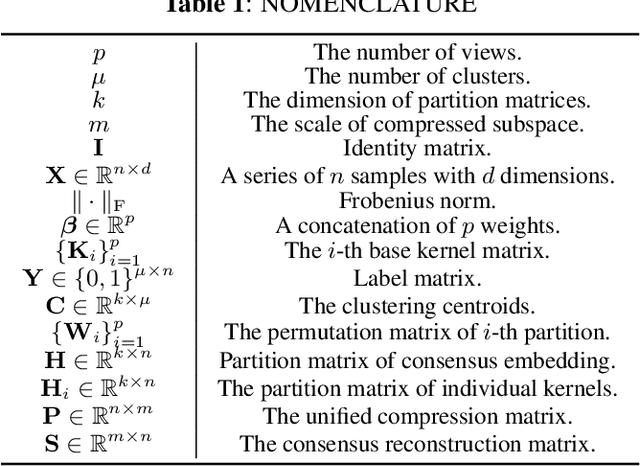

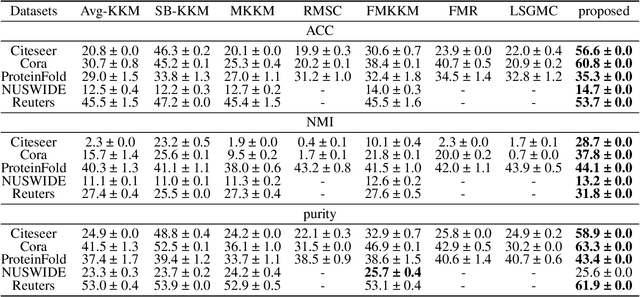
Abstract:Late fusion multi-view clustering (LFMVC) has become a rapidly growing class of methods in the multi-view clustering (MVC) field, owing to its excellent computational speed and clustering performance. One bottleneck faced by existing late fusion methods is that they are usually aligned to the average kernel function, which makes the clustering performance highly dependent on the quality of datasets. Another problem is that they require subsequent k-means clustering after obtaining the consensus partition matrix to get the final discrete labels, and the resulting separation of the label learning and cluster structure optimization processes limits the integrity of these models. To address the above issues, we propose an integrated framework named One-Step Late Fusion Multi-view Clustering with Compressed Subspace (OS-LFMVC-CS). Specifically, we use the consensus subspace to align the partition matrix while optimizing the partition fusion, and utilize the fused partition matrix to guide the learning of discrete labels. A six-step iterative optimization approach with verified convergence is proposed. Sufficient experiments on multiple datasets validate the effectiveness and efficiency of our proposed method.
Anchor-based Multi-view Subspace Clustering with Hierarchical Feature Descent
Oct 11, 2023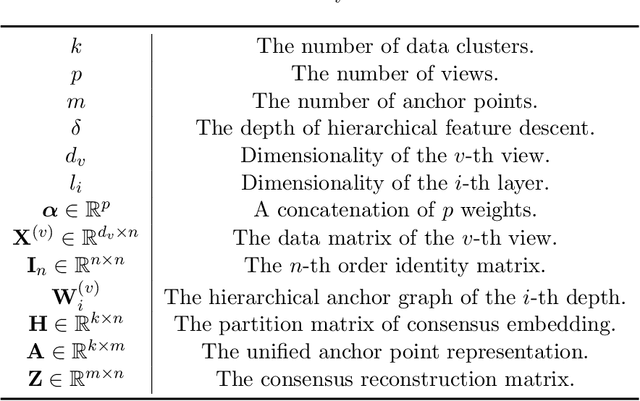

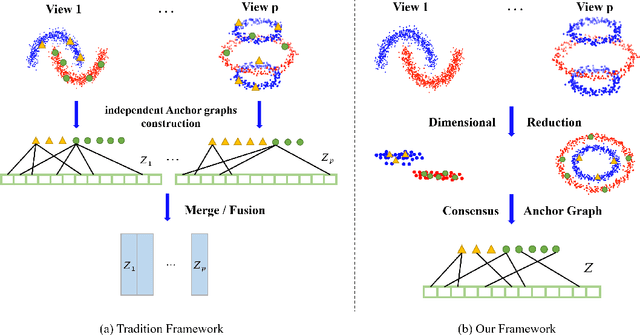
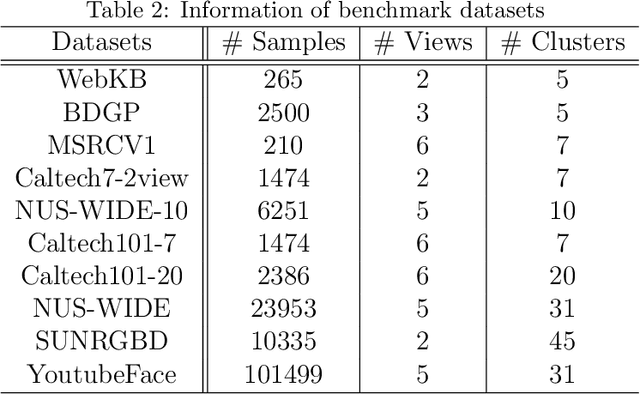
Abstract:Multi-view clustering has attracted growing attention owing to its capabilities of aggregating information from various sources and its promising horizons in public affairs. Up till now, many advanced approaches have been proposed in recent literature. However, there are several ongoing difficulties to be tackled. One common dilemma occurs while attempting to align the features of different views. We dig out as well as deploy the dependency amongst views through hierarchical feature descent, which leads to a common latent space( STAGE 1). This latent space, for the first time of its kind, is regarded as a 'resemblance space', as it reveals certain correlations and dependencies of different views. To be exact, the one-hot encoding of a category can also be referred to as a resemblance space in its terminal phase. Moreover, due to the intrinsic fact that most of the existing multi-view clustering algorithms stem from k-means clustering and spectral clustering, this results in cubic time complexity w.r.t. the number of the objects. However, we propose Anchor-based Multi-view Subspace Clustering with Hierarchical Feature Descent(MVSC-HFD) to further reduce the computing complexity to linear time cost through a unified sampling strategy in resemblance space( STAGE 2), followed by subspace clustering to learn the representation collectively( STAGE 3). Extensive experimental results on public benchmark datasets demonstrate that our proposed model consistently outperforms the state-of-the-art techniques.
Contrastive Continual Multi-view Clustering with Filtered Structural Fusion
Sep 26, 2023
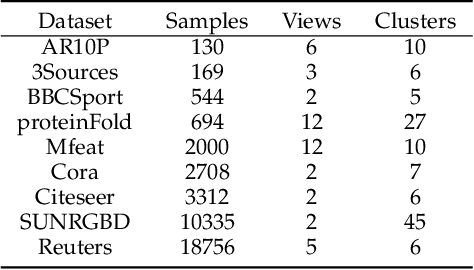
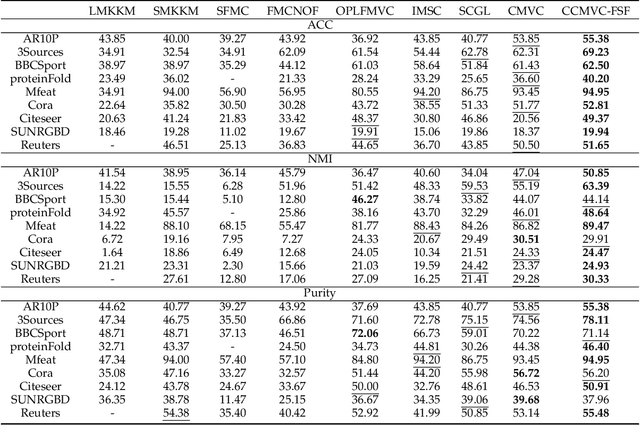

Abstract:Multi-view clustering thrives in applications where views are collected in advance by extracting consistent and complementary information among views. However, it overlooks scenarios where data views are collected sequentially, i.e., real-time data. Due to privacy issues or memory burden, previous views are not available with time in these situations. Some methods are proposed to handle it but are trapped in a stability-plasticity dilemma. In specific, these methods undergo a catastrophic forgetting of prior knowledge when a new view is attained. Such a catastrophic forgetting problem (CFP) would cause the consistent and complementary information hard to get and affect the clustering performance. To tackle this, we propose a novel method termed Contrastive Continual Multi-view Clustering with Filtered Structural Fusion (CCMVC-FSF). Precisely, considering that data correlations play a vital role in clustering and prior knowledge ought to guide the clustering process of a new view, we develop a data buffer with fixed size to store filtered structural information and utilize it to guide the generation of a robust partition matrix via contrastive learning. Furthermore, we theoretically connect CCMVC-FSF with semi-supervised learning and knowledge distillation. Extensive experiments exhibit the excellence of the proposed method.
 Add to Chrome
Add to Chrome Add to Firefox
Add to Firefox Add to Edge
Add to Edge